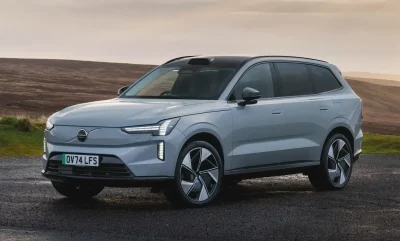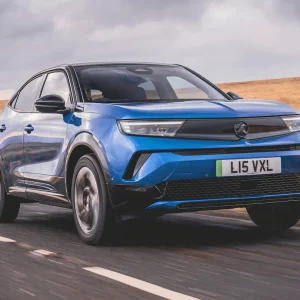
Think Volvo range-topper, and usually you’ll be thinking the XC90, a car that despite the second-generation version being launched back in 2014, has remained relevant and popular, thanks to plug-in drivetrains, and the fact that few rivals are able to match its practicality.
Incoming facelift versions of the XC90 also arrive in 2025, but there’s now a new EV alternative, in the form of the all-new EX90.
Built on a bespoke new architecture, the SPA2 platform, which is shared with the Polestar 3, it has a 111kWh battery pack, 400-volt architecture, and it can be fast charged up to 250kW. Like the Polestar, there are two versions, both with twin motors – the Ultra with 408hp and Performance Ultra with 517hp – with more versions due. The Ultra has 568lb ft of torque, and accelerates to 62mph in 5.9 seconds. Apart from the obvious power hike, the Performance pack version’s 0-62mph acceleration drops to just 4.9 seconds, torque rises to 671lb ft, but the range is the same as the Ultra, at 374 miles.
With DC charging at up to 250kW, a 30-minute 10-80% battery charge is possible, but a full charge on a 7kW AC charger will take 15 hours.
Design and interior
Outside, the EX90 look familiar but different – almost an update of a mixture of EX30 design cues, on an XC90 silhouette. It is a big car but hides its bulk well thanks to clever design – like the tapering bodywork. Design highlights include the pop-out door handles, the distinctive wing mirrors, and the headlights with their large ‘Thor’s Hammer’ DRLs, that open to reveal the main pixel LED units. In fact, the only part of the design we’re not sure of, is the prominent Lidar sensor at the front of the roof, that looks like a London taxi’s light.

Inside, the EX90 carries on and modernises the familiar XC90 feel. The plastics, leather, and wood trims feel premium and expensive. The most prominent feature on the dashboard is the 14.5in touchscreen, that runs the infotainment by Google-based operating system – like the rest of the Volvo range. There is also a smaller screen on the steering column for driver information – such as speed.
The infotainment works well enough, but as with the EX30, we feel there are too many everyday functions hidden in touchscreen menus, such as adjusting the door mirrors, and even opening the glovebox!
The standard panoramic glass roof is an attractive feature, as it lets welcome light into the interior. Headroom front and rear isn’t an issue for the tallest. The driving position is comfortable, and multi-adjustable. There’s also enough legroom in the next two rows for adults to get comfortable – although we’d suggest the third row is more for short trips and children. Elsewhere, the EX90 is fitted with a mega 25-speaker Bowers & Wilkins audio system featuring Dolby Atmos!
The Volvo EX90 is also the brand’s first car to feature centralised computing with the Nvidia Drive core computer, running software from Volvo Cars. Serving as the AI brain, the Nvidia platform can process data from multiple sensors and cameras to enable driver monitoring and assistance features.
Driving
On the road, standard air suspension means that despite standard 22in wheels fitted to both EX90s that we drove, the ride generally was supple and impressed.

Next up is the steering, which has decent weight and response – making both the EX90s we drove feel more nimble than their size and 2.8 tonne weight would suggest. However, the firm settings for both the steering and ride don’t appear to add anything to the dynamics, other than a slightly harsher edge.
Performance-wise, we struggled to notice the difference between the two EX90 versions, and in everyday use would suggest the 408hp of the Ultra is more than enough.
Our only other concern was over the EX90’s range, as both seemed down on Volvo’s predictions. However, in its defence, neither of the cars we drove were fully charged, and the conditions were particularly cold on the day.
The Volvo EX90 is an impressive EV and range-topper, to the point you forget it’s an EV most of the time, it’s been that well engineered. Then again, with prices starting at £96,255 for the Ultra, it should be!

Our best Premium Large SUV, the Kia EV9, does much the same job, although its interior doesn’t feel quite so special, but then again even if you choose the GT-Line S seven-seater range-topper, it is an impressive £20,000+ cheaper.
Positive: Good to drive, refined ride, keen performance, premium look and feel inside and out.
Negative: Expensive, limited model choice at launch, questions about range and efficiency.
Standard equipment: 14.5-inch touchscreen control system with Google built in and 5G connectivity, 25-speaker Bowers & Wilkins audio system featuring Dolby Atmos, head-up display in windscreen, lidar and driver-understanding system (eye tracking and hands on steering wheel detection), four-corner air suspension with adaptive dampers, pixel LED headlights, 360-degree camera system with 3D view, fixed panoramic glass roof, power-operated tailgate with handsfree opening and closing, soft-close doors, four-zone climate control with air-purification system, seven seats.
Engines: Electric: 408hp, 517hp
Equipment grades: Ultra, Performance Ultra
Transmission: Single-speed automatic
| Model | Volvo EX90 Twin Motor Ultra 111kWh |
| P11D | £96,200 |
| Residual value | 37.2% |
| Depreciation | £60,498 |
| Fuel | £4,114 |
| Service, maintenance and repair | £3,835 |
| Cost per mile | 117.4p |
| Range | 374 miles |
| CO2 (BIK%) | 0g/km (2%) |
| BIK 20/40% a month | £32/£64 |
| Luggage capacity | 310 litres |
| Battery size/power | 111kWh/408hp |
| Score | 8/10 |





